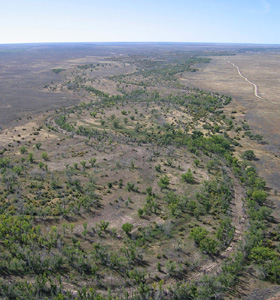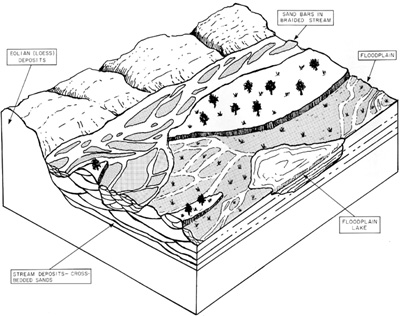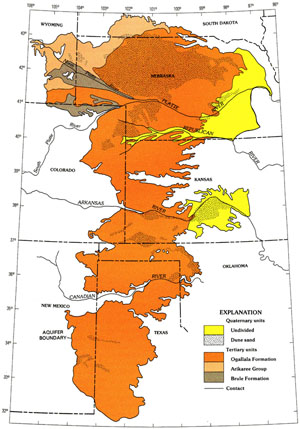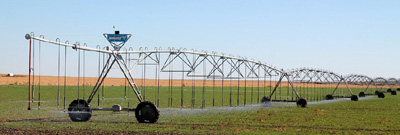
|
Landscapes of the
Central Great Plains
Chapter II
High Plains, Pine Ridge,
White River Badlands
James S. Aber and Susan W. Aber
Emporia State University Emeritus
|
II.1 Introduction
The High Plains begins at the eastern edge of the Rocky Mountains at >7000 feet (2130 m) elevation and slopes downward across eastern Colorado and Wyoming into western Kansas and Nebraska reaching low elevations in south-central Kansas about 1475 feet (450 m). In Kansas, the High Plains occupies most of the western third of the state and extends into central Kansas south of the Arkansas River Lowlands. Southwestern Nebraska and the Panhandle region are also parts of the High Plains, and the Pine Ridge forms a prominent escarpment marking the northwestern edge of the High Plains west of the Sand Hills (see landscape maps).

| Main topographic features of the Nebraska Panhandle region. The Cheyenne Tablelands, Box Butte Tablelands, and Pine Ridge are parts of the High Plains. Adapted from Diffendal et al. (1985).
| |
The High Plains appears to be flat and nearly featureless across long distances. In part this is due to the lack of trees and the ability to see to the far horizon. The High Plains is not entirely featureless, however. Steep slopes and rugged terrain are found locally in Kansas, where small streams have entrenched valleys and ravines into the plains upland, for example along Buckner Creek in Hodgeman County, Ladder Creek in Scott County, and the Arikaree Breaks in Cheyenne County. Prominent buttes appear on the High Plains in northwestern Nebraska.

| The edge of the High Plains upland is marked by the plowed field (lower right) with deeply eroded Pleistocene loess of Arikaree Breaks beyond. The dark green stripe in the distance is the North Fork Republican River valley in Nebraska, some 400 feet lower in elevation. Kite airphoto in Cheyenne County, Kansas. |

| Buttes at Agate Fossil Beds National Monument, Sioux County, northwestern Nebraska. The Arikaree Group is Miocene in age, ~20 million years old (Howard 2017). Note people in distance for scale.
|
Native vegetation of the High Plains is dominated by mixedgrass prairie to the east and shortgrass prairie to the west. The western portion lies in the rain shadow of the Rocky Mountains and typically receives less than 20 inches (50 cm) of precipitation per year. Land use depends to a considerable extent on the availability of water and type of soil. A mixture of dryland and irrigated crops is grown in loess soils that cover much of the uplands, and cattle grazing takes place where soil is too dry or thin, or slopes are too steep for cultivation.

| This relatively austere view of dry rangeland is the general impression most people have for the High Plains in southwestern Kansas. Near Wagon Bed Spring, Grant County. Kite aerial photograph.
|
 Return to beginning.
Return to beginning.
II.2 Geologic foundation
The geologic foundation of the High Plains is a blanket of alluvial sediment that was deposited by a network of braided rivers flowing out of the Rocky Mountains. In addition to alluvial sediment, wind-blown loess (dust) and sand dunes built up in some locations. Across most of the High Plains, this body of sediment comprises the Ogallala Formation of Plio-Miocene age (Gutentag et al. 1984). In northwestern Nebraska, however, older Miocene strata make up the High Plains. This gravelly, sandy sediment buried the pre-existing, mostly Mesozoic, bedrock consisting mainly of chalk, shale and sandstone, and built up alluvial fans that coalesced into a plain extending from the Rockies as far eastward as the northeastern corner of Nebraska and the Flint Hills in Kansas.

| Schematic model for accumulation of alluvial and aeolian sediments during the Miocene in the Nebraska Panhandle. Adapted from Pabian and Swinehart (1979).
| |
The sediment that washed out of the Rockies is comprised mainly of quartz and feldspar sand plus granitic and metamorphic rock fragments in the pebble- and cobble-sized materials. After deposition, the sediment was subjected to weathering and soil-forming processes. Soluble carbonates were leached from the surface and precipitated in the subsurface forming cemented zones, known as mortar beds. In other places, green opal cemented sandstone and quartzite beds into hard rock near the base of the Ogallala Formation. For the most part, however, the Ogallala and other Miocene formations remain poorly consolidated.

| Typical exposure of mortar beds in the Ogallala Formation near Dodge City, Kansas. Overview of cemented pebbly, coarse sandstone (left) and close-up shot (right). Comb for scale is 5 inches long.
|  |

| Left – fossil sand dune exposed in the Arikaree Group at Agate Fossil Beds National Monument, Sioux County, Nebraska. Right – green opaline quartzite from the basal Ogallala Formation in the Hill City Hall, Graham County, Kansas.
| 
|
 Return to beginning.
Return to beginning.
II.3 Geomorphic processes and landforms
When first formed, the Plio-Miocene alluvial plain had little local relief, and streams shifted across its surface frequently. Sediment accumulated under humid conditions of a subtropical savanna (Gutentag et al. 1984). Eventually sediment buildup ended, and streams began to entrench valleys into the former alluvial plain. Several factors led to increased erosion of the High Plains. Since the end of the Miocene, the mid-continent region underwent a dramatic uplift. Regional uplift may be due in part to hot-spot doming (Yellowstone) and overrunning the East Pacific Rise in a low-angle, nearly flat subduction zone.

| West Spanish Peak, dikes, and Goemmer Butte (*) at the western edge of the High Plains near La Veta, Colorado. The intrusion of West Spanish Peak took place underground in the late Oligocene and Miocene in connection with the Rio Grande Rift zone. Since then, uplift and erosion have removed vertically at least 7000 feet (>2 km) of the surrounding Cuchara Formation sediment.
|
The Colorado Plateau, southern Rocky Mountains, and adjacent High Plains were raised several thousand feet (Matthews et al. 2003), and the mountains are still rising today. Regional uplift is attributed to hydration of the lower crust, in which dense minerals, such as garnet, were converted to lighter amphibole and mica minerals, by fluids derived from the Larimide Orogeny (Jones et al. 2015). The High Plains were tilted upward to the west, which increased stream gradients downward to the east.
The modern elevation and slope of the High Plains upland is, thus, a reflection of this tectonic uplift and regional tilting. At the same time, sea level was lowered worldwide as a consequence of increasing polar glaciation, and climate became cooler and drier. These factors in combination led to increased rates of erosion by streams and large rivers, which etched their valleys across the High Plains. In this manner, the Cimarron, Arkansas, Smoky Hill, Republican, Platte, Niobrara, White, and other smaller stream valleys came to resemble their current expression in the landscape. The Ogallala Formation was partly removed by erosion toward the east, which exposed underlying Cretaceous and Permian bedrock of the Red Hills, Chalk Buttes, Blue Hills, Smoky Hills, and Flint Hills regions. The modern High Plains is, therefore, a mere remnant of the much larger Plio-Miocene plain.
During the Pleistocene, glaciation waxed and waned several times in the Rocky Mountains (Richmond 1965, 1986). With each glacial expansion, torrents of meltwater flushed sediments into rivers across the High Plains. Freshly deposited outwash was easily eroded by glacial winds, which carried dust far and wide. The accumulation of dust through several millennia during and after Pleistocene glaciations built up the loess blanket on High Plains uplands eastward from the Rocky Mountains (Gutentag et al. 1984; Matthews et al. 2003).

| Peoria Loess of late Pleistocene age (left). Note the well-developed Holocene soil at top. Scale pole marked in feet. Wallace County, Kansas. Sand hills (right) stabilized by vegetation and used for cattle grazing. Kite airphoto near Scott City, Kansas.
| 
|
Loess in northwestern Kansas, for example, reaches 20 m (65 feet) deep, and thick loess also covers parts of southwestern Kansas (Muilenburg 1961; Muhs 2010). Soils formed in loess of the High Plains are among the most productive in the world. In some regions, sandy sediment was exposed to wind erosion, and sand dunes were created. The dunes are mostly stabilized by vegetation cover nowadays. Active dune formation is relatively young throughout most of the Great Plains (Swinehart 1990). Several episodes of dune activity and severe drought took place during the Holocene: 9600 to 6500, 2300 to 4500, and most recently 1000 to 700 years ago (Miao et al. 2007).
The semiarid climate of the High Plains means that surface water is generally lacking away from major rivers draining the Rocky Mountains (see title image). In the uplands between major river valleys, surface water is particularly scarce. Many thousands of playas dot the southern High Plains of the central United States. These shallow depressions are dry more often than not, but may contain water following heavy rains or snow melts. Playas are especially important for migrating waterfowl and shorebirds and may be key points for groundwater recharge (Steiert and Meinzer 1995). Many opinions have been advanced concerning the origin of playa depressions, ranging from subsurface solution to wind erosion or buffalo wallows.

| Ephemeral lake in a playa basin surrounded by winter wheat (green) and fallow fields. An abandoned county road runs across the far end of the lake. Seen here in 2007, a particularly wet year. Kite airphoto near Scott City, Kansas.
|
Previous estimates for the total number of playas varied greatly; Steiert and Meinzer (1995) cited a value of 25,000 for the southern High Plains with 2000 in Kansas. Other estimates ranged as high as 60,000 total for the region with 10,000 in Kansas (Evans 2010). A GIS analysis of high-resolution aerial imagery, digital raster graphics, and soil data has revealed more than 22,000 playas in Kansas alone, more than twice the previous high estimate (KGCC 2010). In addition, the area between Scott City and Garden City includes several enclosed drainages, such as White Woman Basin and the basin of Dry Lake, that probably were created by a combination of fault movement and subsurface solution, particularly within gypsum members of the Blaine Formation. Like playas, these larger basins may contain streams and lakes during wet years, but are usually dry.

| Views looking over the western portion of Dry Lake. Wet year (left), full of water, and dry year (right) with lake floor covered by salt. Dry Lake occupies an enclosed drainage basin. Kite photographs near Scott City, Kansas.
| 
|
Widespread groundwater beneath the High Plains was indicated by numerous springs draining along the sides of valleys incised into the plains and along the eastern margin of the plains (Haworth 1897). The High Plains Aquifer, which extends from Texas to Nebraska and beyond, has been exploited increasingly since the 1950s, as manifested by the rapid spread of center-pivot irrigation.

| Map of the High Plains Aquifer system. Most of the aquifer consists of the Ogallala Formation (orange); younger Quaternary sediment (yellow) forms the aquifer in central Kansas and eastern Nebraska. Sand hills are indicated by dotted pattern. Adapted from Weeks et al. (1988). |

| Center-pivot irrigation of newly emergent winter wheat in the autumn on the High Plains in western Wallace County, Kansas. Irrigation in this vicinity is based on pumping groundwater from the High Plains Aquifer with unmuffled engines powered by natural gas. Note the low sprinkler heads, just above the ground, to minimize wind loss.
| | |
In some portions of the High Plains Aquifer, the rate of groundwater extraction exceeds the rate of recharge from natural sources of infiltration, which amounts to groundwater mining. This has resulted in declining water tables, reduced springs, minimal stream flows, and dry lakes. In other regions, particularly sand hills areas, recharge may be adequate to maintain groundwater reserves. Several groundwater management districts control development and promote conservation of this valuable resource in the High Plains region.

| Hamilton State Fishing Lake and Wildlife Area on Plum Creek near Syracuse, Kansas. It dates from the 1950s. Dam and outlet tower in left foreground with dry lake basin in background. Given average annual precipitation of only 18 inches, the lake basin is usually dry, although it may hold a shallow pool of water in some wet years.
|
 Return to beginning.
Return to beginning.
II.4 Pine Ridge and White River Badlands
The Pine Ridge marks the northwestern margin of the High Plains (see above), where it forms a prominent escarpment above the White River valley to the north. This vicinity has the greatest local topographic relief of any portion of the central Great Plains. Elevations on the crest of the ridge at Harrison exceed 4800 feet (~1460 m), and the escarpment descends more than 1400 feet to below 3400 feet (~1040 m) in the White River valley at Chadron. The north-facing slopes are relatively cool and wet compared with the High Plains upland; these slopes support a native forest of Ponderosa pine (Pinus ponderosa), for which the ridge is named. Parts of the Pine Ridge are protected in the Nebraska National Forest.

| Pine Ridge of Nebraska. Left – escarpment in the foreground drops steeply toward the White River valley. Near Chadron, Dawes County. Right – ponderosa pine covers the steep slopes of Smiley Canyon beneath a rim of resistant bedrock. Oglala National Grassland, Sioux County.
| 
|

| White River Badlands with the Pine Ridge escarpment on the far left horizon. Note the intricate erosion of the badlands in the foreground. Kite aerial photograph by ESU students.
|
The Pine Ridge is underlain by the Arikaree Group of Miocene age consisting of sandstone, conglomerate, and considerable volcanic ash (NGMDB 2022). These deposits were laid down in streams draining eastward from the Rocky Mountains. The Arikaree Group is well-known for fossils of diverse land mammals, such as those found at Agate Fossil Beds National Monument (see above).
Subsequent erosion, namely by the White River and its tributaries, has cut deeply into the northern margin of the Pine Ridge and exposed the underlying White River Group of Oligocene age (NGMDB 2022). The group is made up of the Chadron Formation and overlying Brule Formation, which consist primarily of claystone and mudstone with thin sandstone layers. Like the Arikaree Group, these strata were laid down by streams draining eastward from the Rocky Mountains. The poorly consolidated sediments have eroded into badlands in the White River valley. Erosion is rapid as demonstrated by collapse of pedestals and other forms during the past few decades.

| Toadstool Geologic Park, Nebraska. In 1978 a large sandstone block perched precariously on an eroded pedestal of mudstone (left). Sometime before 1997, the sandstone block had broken apart and collapsed (right – adapted from Wikimedia Commons). Oglala National Grassland, Sioux County.
| 
|
The White River Group extends into Badlands National Park in South Dakota, where it is capped by Neogene gravel preserved locally on buttes and ridge tops. The White River Group is famous for yielding many vertebrate fossils, especially mammals, as well as freshwater fish, amphibian, reptile and bird species (Hoganson et al. 2007).

| Overview of eroded badland topography in Oligocene strata (left), and close-up shot of Neogene gravel preserved on butte top (right). Pebbles include anorthosite (*) derived from Rocky Mountains in Wyoming. Sunglasses for scale. Badlands National Park, South Dakota
| 
|

| Nearly whole skull of a fossil oreodont exposed in mudstone of the Chadron Formation at Toadstool Geologic Park. Oreodonts were herbivores similar to modern sheep and goats that populated the lush prairie wetlands during the Oligocene. Pocket watch is about 2 inches (~5 cm) in diameter.
|
The Black Hills in southwestern South Dakota are structurally an anticline that was uplifted in the Eocene during the Larimide Orogeny, when other parts of the Rocky Mountains underwent similar uplifts that raised crystalline basement into mountain peaks. Rapid erosion of these mountains led to large volumes of sediment transport and accumulation across the High Plains region, as demonstrated by the White River and Arikaree groups.

| Satellite image of the Black Hills-Pine Ridge region with partial snow cover. True-color MODIS image taken on Oct. 16, 2013. Adapted from NASA Earth Observatory (early blizzard).
| |
Continued post-Miocene erosion of the Black Hills has carved out a series of concentric valleys in softer strata and intervening hogbacks or ridges of more resistant strata that surround the Black Hills. The White River valley and Pine Ridge represent the outermost expression of this valley-and-ridge topography on the southern flank of the Black Hills dome.
 Return to beginning.
Return to beginning.
 Combined references.
Combined references.

 Return to Landscapes table of contents.
Return to Landscapes table of contents.
All text and images © by the authors (2022).




 Return to beginning.
Return to beginning.
 Return to beginning.
Return to beginning. Return to beginning.
Return to beginning.



 Return to beginning.
Return to beginning. Combined references.
Combined references.
 Return to Landscapes table of contents.
Return to Landscapes table of contents.